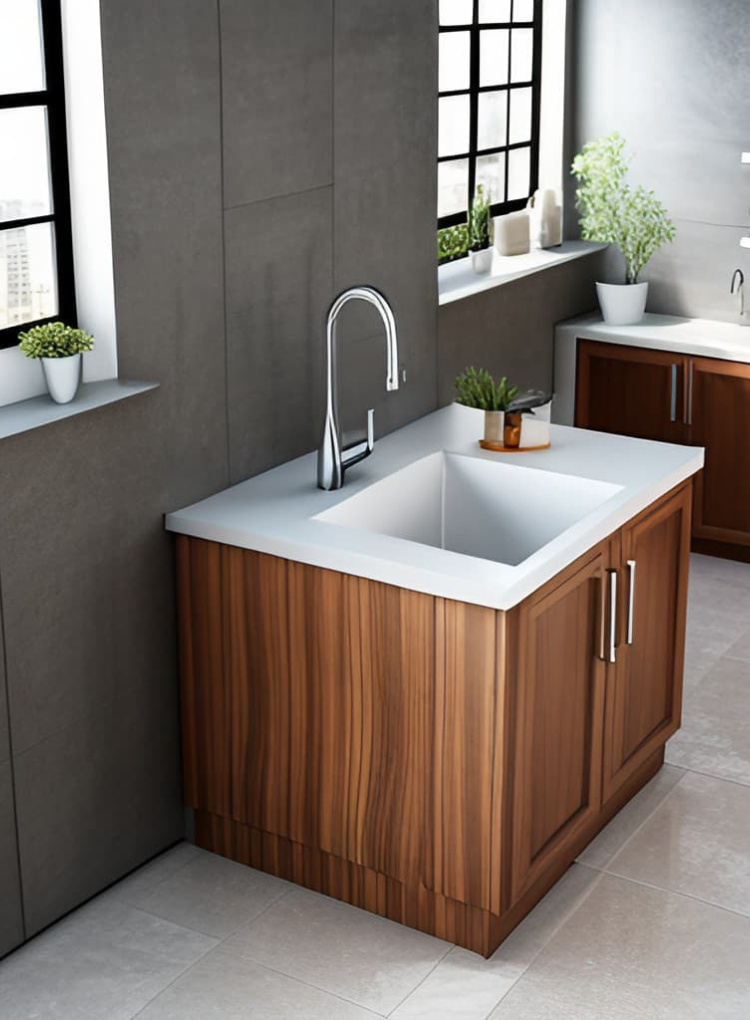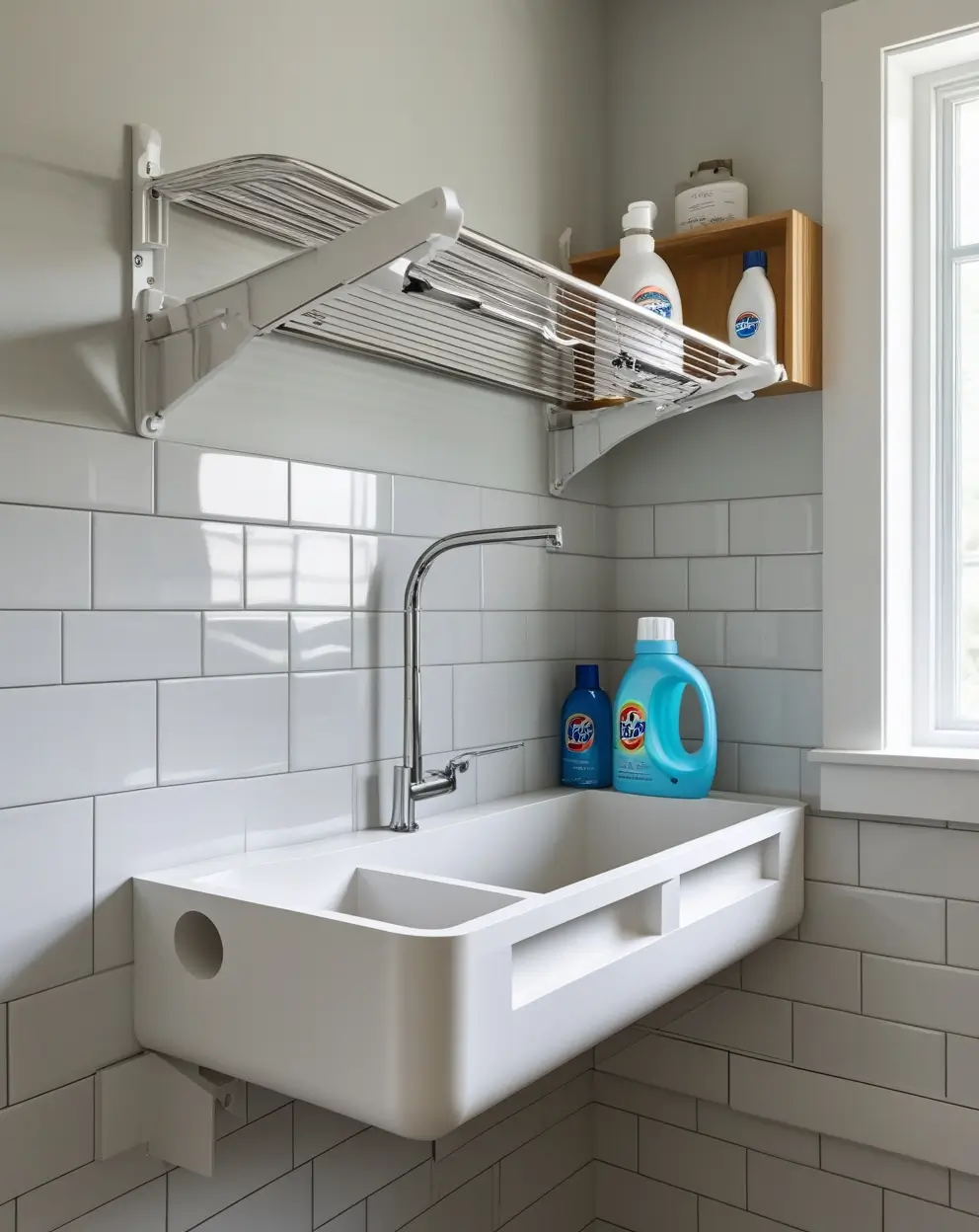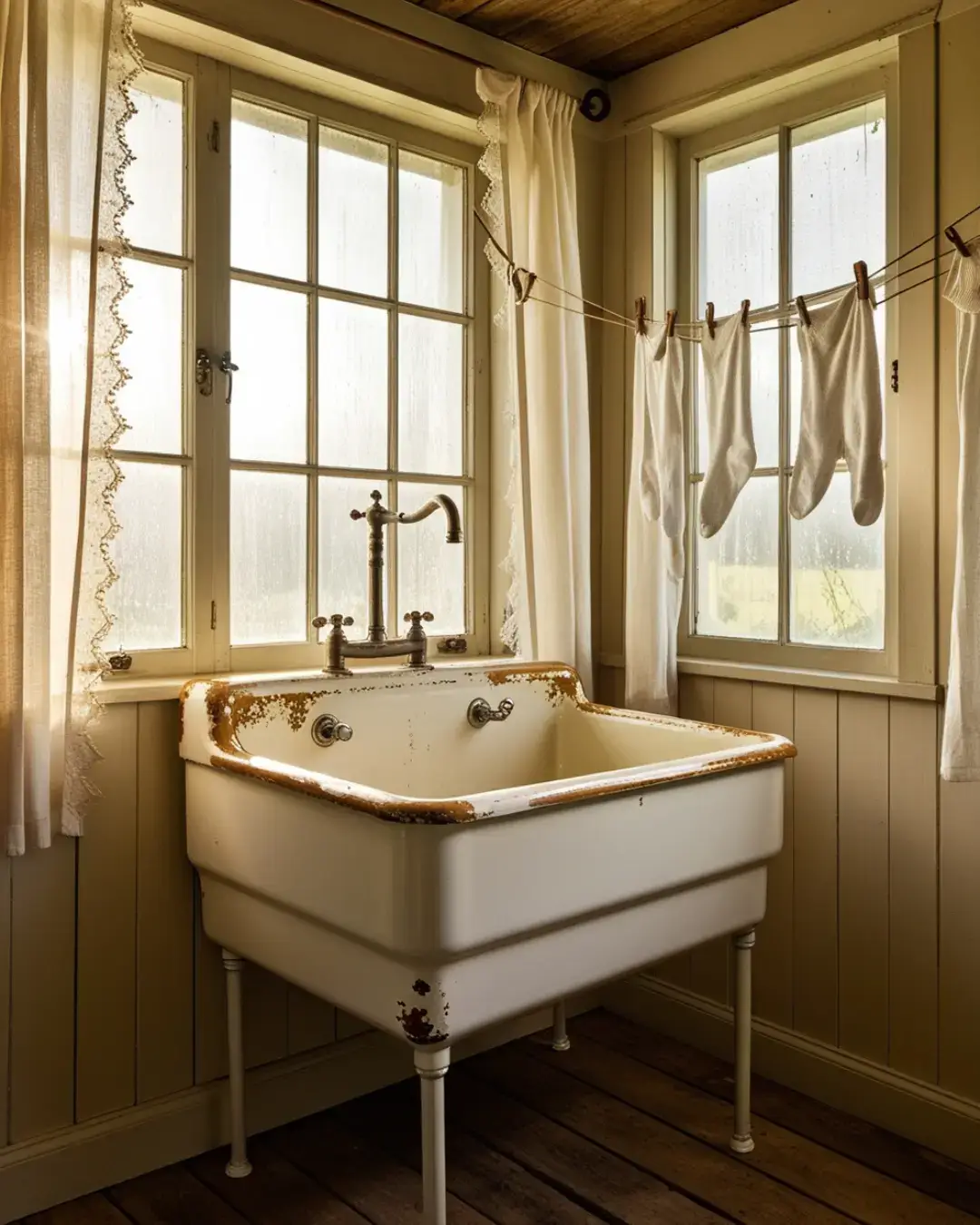Utility Sink Dimensions matter more than you might think! These heavy-duty helpers (perfect for laundry rooms, garages, or workshops) come in sizes ranging from compact 18-inch models to spacious 36-inch basins.
Whether you’re washing muddy boots or soaking bulky bedding, choosing the right dimensions ensures your sink fits your space AND your chores. Let’s break down the ideal sizes and smart shopping tips! 🚰🔧
- The Importance of Choosing the Right Utility Sink Dimensions
- Standard Utility Sink Dimensions
- Variations in Utility Sink Sizes
- 1. Freestanding Utility Sinks
- 2. Wall-Mounted Utility Sinks
- 3. Drop-In Utility Sinks
- 4. Corner Utility Sinks
- 5. Stainless Steel Utility Sinks
- 6. Plastic/Resin Utility Sinks
- 7. Cast Iron/Enamel Utility Sinks
- 8. Two-Compartment Utility Sinks
- Smallest and Largest Utility Sink Sizes Available
- Choosing the Right Utility Sink Size for Your Needs
- How do Different Utility Sink Sizes Serve Different Purposes?
- Installation Considerations
- Conclusion
The Importance of Choosing the Right Utility Sink Dimensions

Picking the right utility sink dimensions ensures your sink works for you, not against you. Too small, and you’ll struggle with bulky items like pet baths or paint rollers. Too large, and it eats up precious space in your laundry room or garage.
Key considerations:
- Task needs (washing tools vs. soaking laundry)
- Available space (measure twice, install once!)
- Comfort height (back pain is not a feature)
The perfect size balances functionality and fit—because even the toughest chores deserve the right setup. 🛠️💦
(Pro tip: Standard depths range 12″-24″—deeper for messy jobs, shallower for tight spaces.*)
Standard Utility Sink Dimensions
Common Utility Sink Dimensions:
- Small (Compact)
- Width: 18-22 inches
- Depth: 16-20 inches
- Height: 30-34 inches
- Ideal for: Tight spaces, light-duty tasks
- Medium (Standard)
- Width: 24-30 inches
- Depth: 20-22 inches
- Height: 32-36 inches
- Ideal for: Most household tasks, laundry rooms
- Large (Heavy-Duty)
- Width: 30-36+ inches
- Depth: 22-24 inches
- Height: 34-36 inches
- Ideal for: Commercial use, bulky items
Key Measurements to Note:
- Bowl depth: Typically 12-16 inches (deeper = better for messy jobs)
- Overall height: Standard is 34″ (consider ergonomics)
- Wall clearance: Minimum 21″ front clearance recommended
Pro Tip: Always measure your space, accounting for plumbing and door clearance, before purchasing! A sink that’s 2 inches too wide can ruin your installation plans.
Variations in Utility Sink Sizes
In addition to the standard sizes, utility sinks come in several types with their own size variations, depending on the installation method. Here are some popular options:
1. Freestanding Utility Sinks

- Features: Deep basin (12-24″ deep), sturdy legs or pedestal base
- Best for: Garages, basements, workshops
- Pros: Easy installation, mobility, heavy-duty capacity
- Cons: Takes up floor space
2. Wall-Mounted Utility Sinks

- Features: Space-saving, brackets secure to studs
- Best for: Laundry rooms, small spaces
- Pros: Frees up floor space, modern look
- Cons: Requires sturdy wall support
3. Drop-In Utility Sinks

- Features: Installs into countertops
- Best for: Craft rooms, mudrooms
- Pros: Sleek built-in look, extra workspace
- Cons: Limited basin depth
4. Corner Utility Sinks

- Features: Fits in 90° corners
- Best for: Maximizing tight spaces
- Pros: Efficient use of awkward areas
- Cons: Smaller basin size
5. Stainless Steel Utility Sinks

- Features: Durable, industrial look
- Best for: Garages, commercial use
- Pros: Rust-proof, easy to clean
- Cons: Noisy, shows water spots
6. Plastic/Resin Utility Sinks

- Features: Lightweight, affordable
- Best for: Light-duty home use
- Pros: Won’t chip or dent, budget-friendly
- Cons: Less heat-resistant
7. Cast Iron/Enamel Utility Sinks

- Features: Heavy, glossy finish
- Best for: Farmhouse-style laundry rooms
- Pros: Stylish, durable
- Cons: Prone to chipping if abused
8. Two-Compartment Utility Sinks

- Features: Divided basins
- Best for: Washing & rinsing tasks
- Pros: Multitasking efficiency
- Cons: Larger footprint
Pro Tip: Pair with a hose-style faucet for maximum versatility! Match the sink type to your space and primary use (e.g., stainless steel for messy garage jobs, enamel for pretty laundry rooms).
Smallest and Largest Utility Sink Sizes Available
🔍 Smallest Utility Sinks
Size:
- Width: 15-18 inches
- Depth: 12-14 inches
- Height: 28-30 inches (shorter for compact spaces)
Best For:
- Tiny laundry closets
- Apartment balconies (for hand-washing)
- RV/camper conversions
Example:
*”A 15-inch wide x 12-inch deep wall-mounted plastic sink in a cramped laundry closet, with a fold-down faucet to save space.”*
🏗️ Largest Utility Sinks
Size:
- Width: 48-60 inches (or larger for commercial)
- Depth: 24-30 inches (extra-deep basins)
- Height: 36+ inches (taller for ergonomics)
Best For:
- Washing large dogs
- Soaking oversized blankets
- Commercial kitchens/workshops
Example:
*”A massive 48-inch stainless steel double-basin utility sink in a brewery, with industrial spray nozzles and grated flooring around it.”*
💡 Key Considerations
- Small sinks: Check drainpipe clearance (tiny spaces may need shallow P-traps).
- Large sinks: Ensure floor reinforcement (cast iron/stone models can weigh 300+ lbs!).
Pro Tip: Need a middle ground? 24-inch wide x 18-inch deep is the “Goldilocks” size for most homes. Measure your space and your largest item (like a bucket or pet tub) before buying!
Choosing the Right Utility Sink Size for Your Needs
When selecting a utility sink, you should consider the following factors to make sure it’s the right fit for your space and your intended use:
Step 1: Measure Your Space
- Clearance Needed: Add 6-12″ around sink for comfortable use
- Door Swing: Ensure doors/cabinets won’t hit the sink
- User Height: 34-36″ height works for most adults (adjust if very tall/short)
Step 2: Consider Your Tasks
- Small (18-22″ wide):
✓ Hand-washing delicates
✓ Rinsing small tools
✗ Can’t fit large buckets - Medium (24-30″ wide):
✓ Soaking shoes/baby items
✓ Washing medium pots
✓ Most household laundry - Large (30-36″+ wide):
✓ Bathing pets
✓ Soaking blankets
✓ Commercial/workshop use
Step 3: Special Features
- Deep basins (16-24″): Contain splashes for messy jobs
- Drainboards: Essential for gardeners/artists
- Two compartments: Ideal for wash/rinse cycles
Pro Checklist:
[ ] Measured available space (width/depth/height)
[ ] Tested clearance with the largest item you’ll wash
[ ] Verified plumbing can accommodate the size
[ ] Considered user height (back pain prevention)
[ ] Choose a durable material for your use case
Smart Tip: For tight spaces, wall-mounted or corner sinks save floor space while still offering 18-22″ wide basins. Always buy slightly larger than you think you need – it’s better to have extra room than struggle with cramped washing!
How do Different Utility Sink Sizes Serve Different Purposes?
Here’s how utility sink sizes match specific needs – because washing a dog isn’t the same as rinsing paintbrushes!
Small Sinks (18-22” wide)
Best for:
- Hand-washing delicates (bras, baby clothes)
- Rinsing gardening tools
- Tiny laundry rooms/RVs
Why? Fits tight spaces but limits large items.
Medium Sinks (24-30” wide)
Best for:
- Soaking stained shirts/shoes
- Washing medium pots/paint rollers
- Pet baths (small dogs/cats)
Why? The “Goldilocks” size – not too big, not too small.
Large Sinks (30-36”+ wide)
Best for:
- Bathing big dogs (Great Danes welcome!)
- Soaking blankets/bulky bedding
- Workshop grease cleanup
Why? Deep basins (16-24”) contain splashes from messy jobs.
Specialty Sizes
- Double-basin sinks: Wash AND rinse simultaneously (perfect for gardeners).
- Extra-deep (24”+): Keeps mop water from sloshing onto floors.
- Wall-mounted: Saves floor space in cramped areas.
Pro Tip: Measure your largest item (like a bucket or pet tub) before choosing. A sink that’s 2 inches too narrow ruins your plans!
Fun Fact: A 30” sink fits most turkey fryers… just saying. 🦃🔥
Installation Considerations
Here are the key installation considerations for utility sinks to ensure a smooth setup:
1. Space & Clearance
- Measure Twice! Account for:
- Width/Depth: Sink + 6-12″ clearance for movement
- Height: Standard 34-36″ (adjust for user comfort)
- Door/Cabinet Swing: Ensure they won’t hit the sink
2. Plumbing Requirements
- Drain Location: Must align with sink’s P-trap
- Water Supply: Hot & cold lines for faucet (or single handle)
- Vent Pipe: Needed to prevent slow drainage
3. Structural Support
- Freestanding: Stable floor (no wobbling!)
- Wall-Mounted: Must anchor to studs (drywall alone won’t hold weight)
- Drop-In: Requires a sturdy countertop
4. Material & Weight
- Stainless Steel/Cast Iron: Heavy—may need reinforced flooring
- Plastic/Resin: Lightweight, easier for DIY install
5. Accessibility
- Hose-Friendly Faucet: For filling buckets/washing pets
- Knee Space (if undermount): Important for seated users
6. Local Codes
- Check if a floor drain is required (common in garages)
- Some areas require backflow prevention for utility sinks
Pro Tip: If plumbing isn’t your thing, hire a pro—leaky sinks = bad day. 😅
(Bonus: Use a flexible drain hose if exact alignment is tricky!) 🛠️
Conclusion
Choosing the right utility sink comes down to space, purpose, and practicality. Whether you need a compact 18-inch wall-mount for tight laundry closets or a giant 48-inch commercial beast for washing muddy dogs, the perfect sink exists.
Remember:
- Small sinks (18-22″) = Delicates & tight spaces ✅
- Medium sinks (24-30″) = Most household tasks 🏆
- Large sinks (30-36″+) = Big jobs (dogs, blankets, workshops) 🐕🔧
- Specialty styles (corner, double-basin) = Solve unique needs
Install smart: Measure carefully, reinforce heavy sinks, and don’t fight plumbing alone if you’re unsure.
A well-chosen utility sink turns chores into convenience—no more balancing buckets in tiny bathroom sinks! 🎉
Now go pick your perfect sink… and maybe thank it later when you’re effortlessly rinsing that paint roller. 😉
Also, don’t forget to update your home with house making ideas. Let us make your home look beautiful.
